2. The Ellipsoid
a. Primary Parameters
An oblate spheroid, also known as an ellipsoid, begins with an ellipse, Figure C-1.
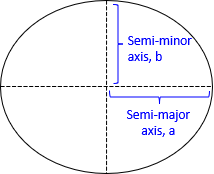 |
| Figure C-1 Ellipse |
Principle parameters used to define and fix an ellipse are its axes (a & b), flattening (f), first eccentricity (e), and second eccentricity (e').
| Equation C-1 | |
| Equation C-2 | |
| Equation C-3 |
Fixing any two of the parameters define the rest.
A circle is a special case of an ellipse were a=b. Its flattening and eccentricities are all zero.
Spinning the ellipse around its semi-minor axis creates a 3D ellipsoid, Figure C-2.
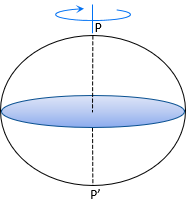 |
| Figure C-2 Ellipsoid |
The ellipse is oriented so its semi-minor axis coincides with the Earth's polar axis, P-P'.
Horizontal slices through the ellipsoid are circular sections; vertical ones are elliptical.
b. Observer's Elements
The normal, N, is a line perpendicular to the ellipsoid at the observer's position, Figure C-3. The distance in the normal direction from the ellipsoid to the ground point is the ellipsoidal height, h, also known as the geodetic height.
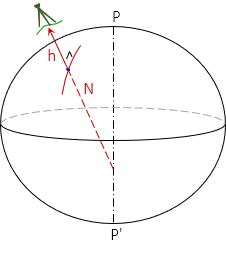 |
| Figure C-3 Ellipsoidal Normal |
The normal intersects along the ellipsoid minor axis. It terminates at the center only if the observer is at either pole or on the Equator.
The observer's meridian, Figure C-4, is the elliptical section containing the observer's normal and the semi-minor (polar) axis, P-P'.
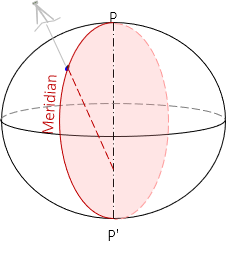 |
| Figure C-4 Observer's Meridian |
The meridian defines geodetic north at the observer's position. Adjacent meridians converge to the poles P and P'.
The prime vertical is a circular section perpendicular to the observer's meridian, Figure C-5. Its radius is N and it defines geodetic east at the immediate location.
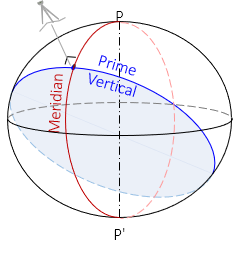 |
| Figure C-5 Prime Vertical |